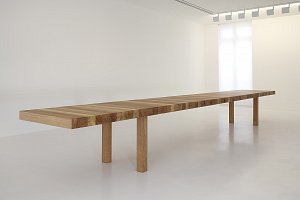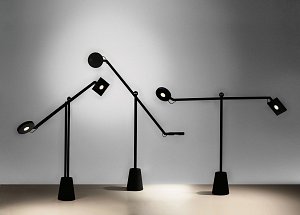
“Table au km”, 2011
Gagosian Gallery and Galerie Patrick Seguin
© DR
Like other major figures of modern architecture, from Mies Van Der Rohe and Le Corbusier to Jean Prouvé, Jean Nouvel has designed furniture over a long period. He often says, “I am not a designer but an architect who designs.” His furniture and household objects are functional, absolutely rigorous and always rooted in the culture of their time, mirroring his conception and practice of an architecture of context. Jean Nouvel’s “anti-design” uses existing typologies, rejecting too “talkative” and too conceptual furniture and prioritizing the elemental. In 1987, given “carte blanche” by VIA (Valorisation de l’Innovation dans l’Ameublement), he designed a line of furniture comprising five aluminum prototypes. Running counter to the aesthetic tendencies of the 1980s, aluminum evokes for him the exploration of technological and scientific advances. With his wealth of experience and to accompany and extend his architectural projects, in 1995 he created JND (Jean Nouvel Design) to develop and publish his furniture projects and objects.
In 1998, Jean Nouvel redesigned the Musée des Arts Décoratifs’ Graphic Design and Advertising spaces. Leaving the ornate moldings, parquet floors and circulation spaces of these former apartments in the Louvre intact, he created modular exhibition spaces with removable Galva screens. Jean Nouvel is returning to these spaces almost twenty years later to show his “types,” the iconic pieces he has been developing for thirty years, and the Less and Less Less office furniture ranges. They perfectly embody the Jean Nouvel method: taking an elementary form and constantly perfecting and lightening it with his minimalist vocabulary. He explores each typology, infinitely experimenting with its combinations and expressing the notion of “zero design” with which he reduces the object, whether a shelf, armchair or table, to its most archetypal form. Jean Nouvel’s design plays fully on the modular and transformable, on the reversible and foldable. It is the work of an “architect who designs,” a design that redefines space and its rhythms.

“Triptyques”, 2014
Walnut and colored mirrors, Gagosian Gallery
and Galerie Patrick Seguin
© Aline Coquelle
Jean Nouvel wanted to integrate this autonomous presentation into the Musée des Arts Décoratifs’ collections, and particularly his favorite periods: the Middle Ages, the Renaissance and the 17th and 18th centuries. He has created moments of contemplation and poetry, inviting visitors to sit on the leather seats he designed for the Abu Dabi Louvre (2016). The sensation of the infinite produced by the Table au Km (2011) echoes the altarpieces and Pietàs, his marble carpets (2016) resonate with Renaissance intaglia, and the Milana chair (1995) with the polychrome wood sgabelli.
In the 17th and 18th-century rooms, his large colored Triptyques mirrors (2014) create multiple narrations, capturing fragments of space and transforming our initial perceptions with their gold, orange and red reflections without the slightest theatricality. Jean Nouvel’s major concern, light and its metamorphoses creates novel experiences by plunging us into semi-darkness, leaving us to discover a new museum space in which light reveals the full poetry of each object.

“Equilibrist”, 2014, Artemide
© DR
The most exhaustive possible respective of his furniture and objects, the Jean Nouvel, mes meubles d’architecte exhibition highlights a lesser-known facet of one of the greatest contemporary architects. Often responding more to his desire to experiment than to specific commissions, this radical body of work reveals a more intimate facet of the thinking and work of the winner of the 2008 Pritzker Architecture Prize.